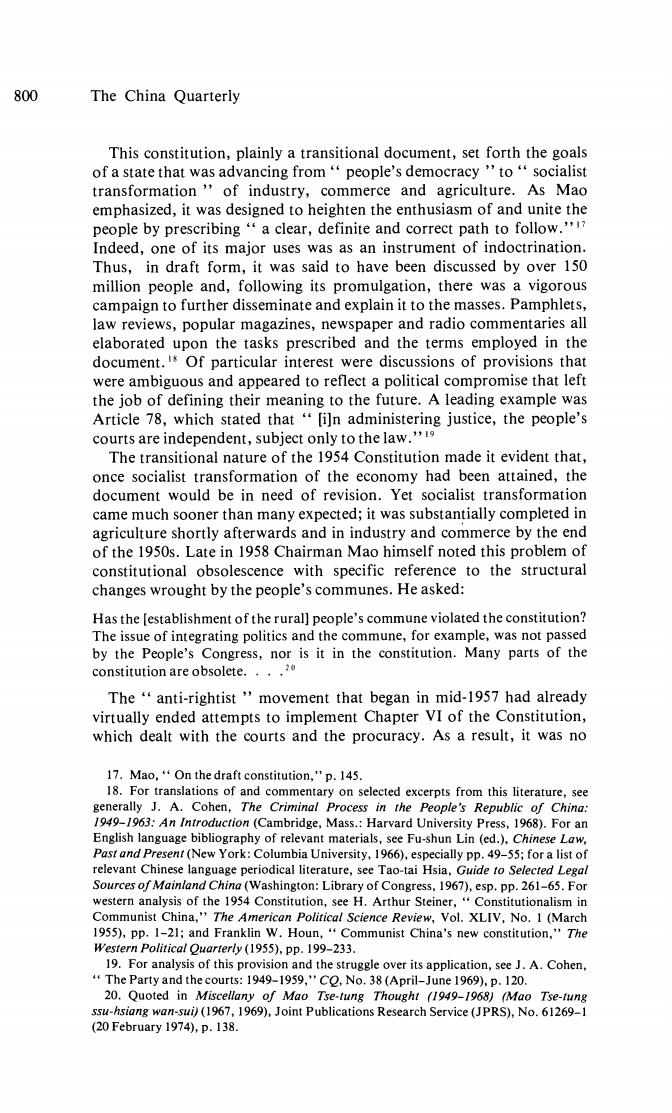正在加载图片...

800 The China Quarterly This constitution,plainly a transitional document,set forth the goals of a state that was advancing from'people's democracy ''to "socialist transformation'of industry,commerce and agriculture.As Mao emphasized,it was designed to heighten the enthusiasm of and unite the people by prescribing"a clear,definite and correct path to follow."7 Indeed,one of its major uses was as an instrument of indoctrination. Thus,in draft form,it was said to have been discussed by over 150 million people and,following its promulgation,there was a vigorous campaign to further disseminate and explain it to the masses.Pamphlets, law reviews,popular magazines,newspaper and radio commentaries all elaborated upon the tasks prescribed and the terms employed in the document.s Of particular interest were discussions of provisions that were ambiguous and appeared to reflect a political compromise that left the job of defining their meaning to the future.A leading example was Article 78,which stated that "[i]n administering justice,the people's courts are independent,subject only to the law.' The transitional nature of the 1954 Constitution made it evident that, once socialist transformation of the economy had been attained,the document would be in need of revision.Yet socialist transformation came much sooner than many expected;it was substantially completed in agriculture shortly afterwards and in industry and commerce by the end of the 1950s.Late in 1958 Chairman Mao himself noted this problem of constitutional obsolescence with specific reference to the structural changes wrought by the people's communes.He asked: Has the [establishment of the rural]people's commune violated the constitution? The issue of integrating politics and the commune,for example,was not passed by the People's Congress,nor is it in the constitution.Many parts of the constitution are obsolete....? The "anti-rightist"'movement that began in mid-1957 had already virtually ended attempts to implement Chapter VI of the Constitution, which dealt with the courts and the procuracy.As a result,it was no 17.Mao,"On the draft constitution,"p.145. 18.For translations of and commentary on selected excerpts from this literature,see generally J.A.Cohen,The Criminal Process in the People's Republic of China: 1949-1963:An Introduction(Cambridge,Mass.:Harvard University Press,1968).For an English language bibliography of relevant materials,see Fu-shun Lin (ed.),Chinese Law, Past and Present (New York:Columbia University,1966),especially pp.49-55;for a list of relevant Chinese language periodical literature,see Tao-tai Hsia,Guide to Selected Legal Sources of Mainland China(Washington:Library of Congress,1967),esp.pp.261-65.For western analysis of the 1954 Constitution,see H.Arthur Steiner,"Constitutionalism in Communist China,"The American Political Science Review,Vol.XLIV,No.1 (March 1955),pp.1-21;and Franklin W.Houn,"Communist China's new constitution,"The Western Political Quarterly (1955),pp.199-233. 19.For analysis of this provision and the struggle over its application,see J.A.Cohen, The Party and the courts:1949-1959,"CQ,No.38 (April-June 1969),p.120. 20.Quoted in Miscellany of Mao Tse-tung Thought (1949-1968)(Mao Tse-tung ssu-hsiang wan-sui(1967,1969),Joint Publications Research Service (JPRS).No.61269-1 (20 February1974),p.138.800 The China Quarterly This constitution, plainly a transitional document, set forth the goals of a state that was advancing from " people's democracy " to " socialist transformation" of industry, commerce and agriculture. As Mao emphasized, it was designed to heighten the enthusiasm of and unite the people by prescribing " a clear, definite and correct path to follow." 17 Indeed, one of its major uses was as an instrument of indoctrination. Thus, in draft form, it was said to have been discussed by over 150 million people and, following its promulgation, there was a vigorous campaign to further disseminate and explain it to the masses. Pamphlets, law reviews, popular magazines, newspaper and radio commentaries all elaborated upon the tasks prescribed and the terms employed in the document.l8 Of particular interest were discussions of provisions that were ambiguous and appeared to reflect a political compromise that left the job of defining their meaning to the future. A leading example was Article 78, which stated that " [i]n administering justice, the people's courts are independent, subject only to the law. " 19 The transitional nature of the 1954 Constitution made it evident that, once socialist transformation of the economy had been attained, the document would be in need of revision. Yet socialist transformation came much sooner than many expected; it was substantially completed in agriculture shortly afterwards and in industry and commerce by the end of the l950s. Late in 1958 Chairman Mao himself noted this problem of constitutional obsolescence with specific reference to the structural changes wrought by the people's communes. He asked: Has the [establishment of the rural] people's commune violated the constitution? The issue c)f integrating politics and the commune, for example, was not passed by the People's Congress, nor is it in the constitution. Many parts of the constitution are obsolete. . . 2 0 The " anti-rightist " movement that began in mid-1957 had already virtually ended attempts to implement Chapter VI of the Constitution, which dealt with the courts and the procuracy. As a result, it was no 17. Mao, " On the draft constitution, " p. 145. 18. For translations of and commentary on selected excerpts from this literature see generally J. A. Cohen, The Criminal Process in the People's Republic of China: 1949-1963: An Introduction (Cambridge, Mass.: Harvard University Press, 1968). For an English language bibliography of relevant materials, see Fu-shun Lin (ed.) Chinese Law, Past and Presenf (New York: Columbia University, 1966), especially pp. 49-55; for a list of relevant Chinese language periodical literature, see Tao-tai Hsia, Guide to Selected Legal Sources of Mainland China (Washington: Library of Congress, 1967), esp. pp. 261-65. For western analysis of the 1954 Constitution, see H. Arthur Steiner, " Constitutionalism in Communist China,a' The American Political Science Review, Vol. XLIV, No. 1 (March 1955), pp. 1-21; and Franklin W. Houn, " Communist China's new constitution," The Western Political QuarSrly ( 1955), pp. 199-233. 19. For analysis of this provision and the struggle over its application, see J. A. Cohen, " The Party and the courts: 1949-1959," CQ, No. 38 (April-June 1969), p. 120. 20. Quoted in Miscellany of Mao Tse-tang Thought (1949-1968) (Mao Tse-tung ssu-^siang wan-sui) (1967, 1969), Joint Publications Research Service (JPRS), No. 61269-1 (20 February 1974), p. 138